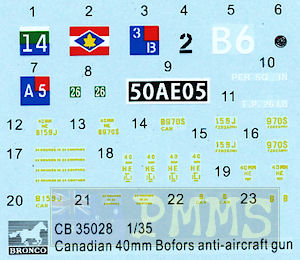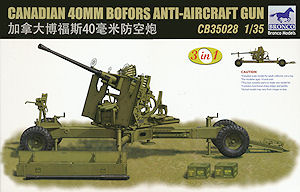
Canadian 40mm Bofors Anti-Aircraft Gun
Bronco Models 1:35 Scale Kit No. CB-35028
Review by Terry Ashley
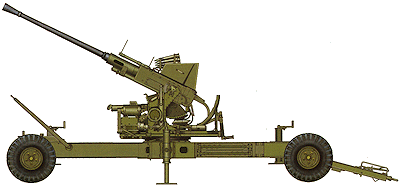
The Bofors was also used extensively buy other Allied Armies most notably Canada who produced the majority of WWII guns as well as by the Australian Army and just about every Allied country involved in WWII for that matter.
Originally mounted on a four wheel trailer, later versions were on a two wheel trailer for airborne use as well as self propelled versions as local modifications (North Africa for example) and purpose built vehicles such as the Crusader AA.
After WWII the Bofors was further developed as the L/70 and used by many nations as both Naval and Army types right up to present day with the 40mm Bofors being one of the longest serving artillery weapons produced.
The kit is labelled “3 in 1” and offers alternate choices for travel or firing modes, the choice of Canadian Mk.C2 or British Carriage Mk.II for the gun platform as well a choice of manual or electric control types. You need to make your selection before commencing as there are different parts for the carriage and control types, you can also build the kit with or without the gun shields fitted.
Added to that you have a choice of 2 types of barrel travel lock, automatic loader hoods plus the simple double ring sights or the British-designed Stiffkey sight, this all means there are some parts left over depending on the version being built.
The kit consists of 291 parts in beige plastic, 18 small wing nuts in light grey plastic, 1 metal spring, 81 etched parts plus the decal and instruction sheets.
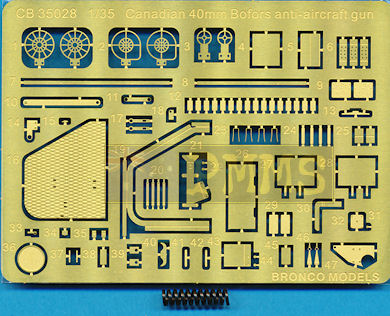
Plastic wing nuts

While not having any available 1:35 plans the kit matches available data well and the level of detail included matches reference photos of the actual gun very well which all makes for a good start. I’ll have to leave any dimensional issues till more detailed info is available.
The moulding quality is very well done with clean crisp mouldings and detail such as weld beads on the breech casing assembly plus moulded on data panels and more weld beads on the chassis transport frame. Other surface details of bolt heads etc are also finely done with no pin marks evident on the parts and just the usual moulding seams to be removed. This needs some care on the very small parts and the larger finely moulded parts like the ribs on the Stiffkey sight, due to the finesse of some parts there is the odd minor flash but this is a bare minimum with the majority of parts cleanly moulded.
Many of the sprue attachments are laid over the part mating surface and not the actual part which makes the cleanup easier without compromising the detail but again take care with the small parts as the attachment but is quite prominent in relation to the size of the part.
One word of caution with the many small plastic and etched parts in the kit and that is to work well over your work bench as the dreaded carpet monster is waiting with salivating jowls for you to dare drop any parts during assembly.
The barrel tube is in one piece including the flash hider which is fully hollowed out and apart from the moulding seam on the barrel tube the only other cleanup is to slightly thin the inside lip of the flash hider for a better appearance. Added to the barrel tube is the recuperator spring provided as an actual metal spring that fits over the rear barrel shank with the barrel end trapped between the two part gun breech. Leave a 2mm gap between the breech and recuperator spring to allow this to fit over the front of the breech casing assembly as you fit these together.
The barrel and flash hider are perfectly acceptable but if you want to replace this with a metal barrel there is a ready made replacement in the form of the Lion Roar 40mm Bofors AA Gun barrel, set #LB3531. This would just need the plastic barrel to be cut off at the appropriate spot, a hole drilled for the LB barrel pin for a straight swap.
At the back is the full automatic loader assembly in six parts that includes the lower automatic loading tray and again the detail on the parts very well done including the inner feed pawl on the left and right frame. These and the rear cover also have excellent flush screw detail included and added under the recuperator spring housing is the recoil cylinder in two parts.
The barrel/breech and automatic loader are trapped between the breech casing assembly halves on small inside guides as the halves are glued together and the instructions indicated the whole barrel/breech will recoil using the spring. But his is quite impractical as the spring was a very tight fit over the shank and the recuperator spring cover had to be glued firmly to the barrel assembly to ensure the top and bottom join seam was as small as possible.
Also given the many delicate sub-assemblies added to the gun as you go along I really don’t think anyone will be playing with the barrel recoil, so just glue everything together for a more positive assembly.
Added to the assembled gun is the top and side covers, you could leave these open to show the inner detail in a diorama setting with the gun undergoing maintenance if you wished? Other details include two underside bolt strips and the left side hand operating lever with two alternate styles provided with the simple L shaped lever (part F9) being the more common seen in photos. Also provided is a 4 round ammo clip to add inside the auto feed should you want and the fit is perfect with the clip held snugly in place without the need for glue.
Another nice inclusion is two different style of automatic loader hoods with separate etched handles and these covers are moulded extremely thin and fit perfectly over the automatic loader without the need for any trimming; note these covers are usually only fitted when the gun is in the transport mode.
The two equilibrator cases and their joining trunnion bracket are moulded as one piece with just separate end caps and this eliminates any unsightly join seam with just the fine mould seam to remove. The two pistons fit inside the cases and join to the sides of the elevating arc but it’s best to leave these off until the gun is mounted between the two carriage frames later.
Amongst the delicate sub-assemblies with the kit are the large sights mounted on the front of the gun housing with two types provided in the kit. There is the initial double ring sights or the British-designed Stiffkey sight as mentioned above with the double ring sights being the easiest to assemble if you don’t feel up to the intricate Stiffkey sight?
The double ring sight has the one piece ‘H’ tube frame with the four etched ring sights added front and rear, with the larger ones at the front obviously. Added to each of the etched sights are two of the small wing nuts provided and I found it best to drill small 0.45mm holes into the plastic sight mounts and insert the wing nut shaft into the hole. The etched sight already has 0.45mm holes included for the wing nuts so you use these as a guide to drill into the plastic after attaching the sights with cyanoacrylate, ensure you firmly hold the plastic frame with tweezers while drilling or there could be problems.
The Stiffkey sight is a different proposition as it is made up of 17 fine plastic and 7 very small etched parts with the cleanup of the fine moulding seams on parts F8 and F14 in particular requiring extreme care not to damage the very fine mouldings. Part F14 the large triangular frame must be about as fine you could mould something in plastic and it’s probably best to clean up the mould seams while the part is still attached to the sprue for a bit more support.
Assembling the sight is fairly straightforward really providing you take your time to ensure the right part goes in the right place and allow time for the glue on one part to ‘go off’ before attaching the next. The only adjustment required was to enlarge the locating holes in part F10 for the pins on part F8 for a better fit but other than that everything fitted nicely which did ease some of the pain with so many small and delicate parts.
Once assembled you again have to handle this with care and it’s definitely a case for leaving this off until the very last to avoid damage, but the finesse of this sub-assembly sort of sums up the quality of the whole kit providing you take your time.

Added to the right carriage frame is a small elevation fuse box if you are building the electric control version as well as ammo rack for two 4 round ammo clips. This is quite an intricate assembly made up of seven etched parts and two plastic mounting posts with the two long brass strips (parts P7, P8) for the W brackets having to be bent to shape.
Bronco gives you a plastic jig to bend these and providing you make the first bend exactly dead centre of the strip it is quite straightforward to bend the strips to the required shape with the usual care of course. Don’t anneal the brass before hand as you want this strong enough to hold the ammo clips once bent to shape and using the jig negates the need for annealing in any case. The base plate (part P22) has a few bends required with engraved bending lines to indicate the correct position and added to this are two small etched bolt heads and two small brackets at the rear of the plate as well as the two W brackets attached to the front and rear mounting stubs.
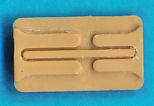
It is best to solder these parts especially the W brackets as the attachment point is the bottom of the W curve and the small mounting stubs bent up from the base plate, using cyanoacrylate simply will not hold these parts together considering the small contact point and that you have to add the two 4 round ammo clips later.
Soldering the W brackets to the base stubs is easier than it sounds by holding the W brackets inverted in a small clamp, reversible tweezers or “spare” hands which ever you prefer and with a pair of tweezers hold the base plate in position over the W brackets ready solder. Add a small amount of flux and the smallest chunk of solder on the join and then apply the heated soldering iron, not to the solder itself but just touch the brass near the join and the heat will melt the solder which will run between the bracket and stub to form the join.
Repeat for the other three joins and provided you hold the base plate in the precise position as you apply the iron tip there shouldn’t be any problems, not actually touching the join with the iron tip also prevents this moving as you apply the heat. Just remember to use the smallest chunk of solder to avoid excess, I sliced a small sliver off 1mm rod solder and then cut that in half again, that is all the solder needed for such a small join.
The two plastic support rods have to be then attached using cyanoacrylate and these are then glued to the small attachment lugs on top of the right carriage trunnion, you may want to leave this assembly off until final assembly to avoid any damage as it to sticks up asking to be broken off in the meantime.
The 4 round ammo clips provided fit perfectly into the W brackets thanks to the jig provided to get the shape right in the first place.
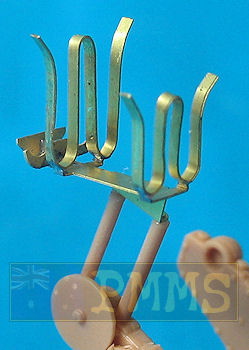
Both have the central turntable to which is added the platform frame and loading platform as well as centrally located shell ejection tunnel. The lower channel (part E36) has additional bolt heads cut from the sprue G runner added to the inside channel as these would be impossible to include using normal moulding techniques. The round tunnel cover has a small bracket with two fine plastic pins and an etched strip added along with the rear mounted shell chute. Note; there is different small fittings added depending the control option selected as noted in the instructions.
For the electric control version there is a large distribution box mounted centrally over the tunnel which is made up of four parts. There are three electrical cable connectors on either side of the box to which is connected a series of cables on the actual gun supplying power to the various devises mounted around the gun and these cables would have to be added to fully complete the model.
The 40mm Bofors M1 and M2A1 Tech Manual CD from Easy 1 Productions (#T006) includes a wiring diagram for this distribution box which will be invaluable when adding the cabling.
A pair of foot rests is added to the front of the platform frame and the left side rests are different for the electric control version with an added etched lever, this again is called out in the instructions.
The loading platform is again different for both version with the British version having a full width platform and this is moulded extremely thin so take care as it will flex if handled roughly. Note this does not have any tread plate but is smooth which is correct for this platform type. Added to this is a crowbar and sledge hammer with moulded on clips plus a couple of other fittings and the platform is added to the rear of the platform frame.
For the Canadian version the loading platform is only on the left rear side of the platform frame with the loading platform itself being in two etched parts. One part is the outer frame/lip of the platform which requires you to carefully bend the frame/lip to include the curved section at the corners, this shouldn’t be a problem and again soldering this would be the best option for added strength.
Added inside the frame is the brass platform floor which includes nice tread plate applicable to this platform with the rear shell chute support added to the rear frame, and to the back of the platform as on the British version. This support is made up of four plastic and one etched part and requires care to assembly as do most of the smaller sub-assemblies around the gun.
For the electric control version there are two large multipart electric motors added to the front of the carriage on small mounting plates with the motors made up of ten parts each for good detail definition but again there is some electrical cabling that should be added to finish off.
On the rear platform is a small azimuth indicator gauge with a small decal provided for the dial face but there is no locating point indicated for adding the gauge to the platform and it’s best not to glue this until after adding the traverse gear and extension shaft (part C17) as the azimuth indicator gauge is located just inboard of the shaft.
Also added to the side of the central shell ejector channel is a small azimuth power switch and fuse box and again there should be some wiring added between the two to finish off, the Easy 1 CD Manual again has details on the wiring required.
Moving to the right side traverse gear, this is an extremely delicate sub-assembly made up of seven plastic and one etched part and the two parts (E3, E4) that make up the mounting post fit together well but are extremely thin at the joins require care when gluing together and handling afterwards.
The level of detail obtained due to the multi part assembly is extremely good and the delicate nature of the assembly is a small price to pay but due care is needed. This sub-assembly mates with the electric motor when mounted on the platform frame.
Added to either side of the platform frame is the two crew seats in two parts each (seat and back rest) and another two parts for the mounting post that includes the tightening lever for more excellent detail.
There is an issue with the seat back rest (part E26) in that the support arm is too short and if assembled as is will have the back rest positioned in the middle of the seat making for an interesting sitting position?
To fix this you simply need to add a 1.6mm section of plastic card strip to the support and then glue this to the underside of the seat as per the original part; this will have the back rest line up with the rear edge of the seat where it should be.
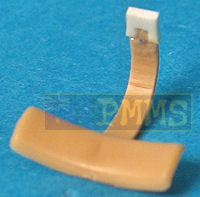
Finally there are the optional shields made up of four parts, two per side to reflect the spaced shields with the rear section including the upper mounting frames. The shields have the inside edges bevelled sharply to a thin edge while the middle is somewhat thicker but there is still a gap between the shields. The locating pins also simulate the shield bolts with the overall effect giving a good visual representation of the spaced shields from most angles.
The shields are attached to the platform frame by way of two long and two short supports and you can easily add the shields at any time or leave them off depending on your choice as not all guns had them fitted.
The shields are prime candidates for etched replacements for a uniform thickness spaced shields as there is not a lot else that needs replacing with the inevitable update set given the quality of the kit as it comes.
The main chassis is a large moulding that includes the rear axle mounting and central outrigger supports with two central bulkheads and underside plate added for the main assembly. Detail on the chassis is very well done with just a minor moulding seam to remove and includes nicely done weld beads along to top and bottom of the chassis. The fit of the lower plate is very good not requiring any trimming or filler.
Added to this are smaller fittings as well as the outrigger/chassis securing stakes and their mounting brackets. For the travel mode the stakes are simply glued to the sides of the chassis and the attachment brackets are small etched parts (all 16 of them) that need to be bent to shape which is best done using the stake as a jig to get the right spacing for the bracket.
When attaching the etched brackets you should also use the stakes as a guide to fit these at the correct width on their mounting plate but take care not to glue the stake in the process. This will allow you to fit the stakes at any time or just for a realistic fit.
Added the rear axle is the axle attachment brackets and additional etched parts for the axle junction box and a couple of small sub-assemblies made up of several very small parts requiring care to assemble. This junction box appears to only applicable to the electric control version but there are numerous different fittings on the Bofors and this may again be one of them?
The tyres are moulded in one piece as they were in Bronco’s recent Sd.Kfz.221 kit #CB-35022, resulting in very well done and clean tread pattern detail and being in the same plastic as the rest of the kit makes them just as easy to work with.
The inner sidewalls of the tyres are two separate parts (inside and outside walls) with another two parts for the wheel rims/hubs. The sidewalls sections include finely embossed “FIRESTONE” and tyre data while the rims have excellent details including the inner rows of rivets and outer hub nuts.
There are different rims for the front and back wheels so take note of the instructions and assembling the wheels is quite straightforward. I did add the outer sidewall section first to ensure these aligned perfectly with the main tyre and allowed the glue to dry completely before adding the rims and inner sidewall sections. There was some minor smoothing out of the inner sidewall/tyre join but this was easily done with a pass of the #11 blade.
You should also note the tread direction when adding the wheels to the respective axles as this is mirrored on either side so again check the instructions closely for this.
One point with the wider tyres including with the kit, there are a couple of preserved museum examples of the 40mm Bofors with these style wheels but most WWII pics I’ve seen have the thinner tyre/wheels combination and not sure if those in the kit are actual WWII pattern wheels or possibly post war style wheels? Hopefully more info will come to light on that, but the wheels themselves are very well done in the kit.
The round outrigger legs are in two halves each and the fit is very good resulting in the smallest of join seams only requiring minor sanding to eliminate after the glue has dried. There are more of the etched stake brackets to add to each outrigger using the same method as with the chassis stake brackets.
The assembled outriggers can be added to the chassis in the extended or travel position and there are hinged covers that close off the chassis opening when the outriggers are stowed in the travel position. These covers are supplied as etched parts with fine plastic hinge parts that making attaching the covers the chassis easy. The etched covers have two strips included that you bend around the plastic parts to form a working hinge allowing you to position the covers open for when the outriggers are extended or closed when stowed.
There are also four fine plastic pins that fit through the chassis and outriggers to secure these in place with different thickness pin for the extended or stowed position and care is needed when fitting these due the finesse of the pins. The actual pins are attached to the chassis/outriggers by safety chains but these are not included so will need to add these from either etched chain or fine chain found elsewhere.
The front steering assembly with drawbar is another multi-part assembly and there are a couple of minor sub-assemblies for the tow hitch and handbrake and these as well as three other small parts that are trapped between the two drawbar sides and care is needed when fitting these together to ensure everything lines up correctly. There are also two very fine grab handles added to the drawbar assembly that will require careful handling due the thin bars.
The front wheels/tyres assemble in the same manner as the rear wheels and these are easily attached to the axles but again watch the direction of the tread pattern when fitting the wheels. The instructions indicate these can be made to rotate but this is very difficult due to the parts involved and far easier to simply glue the wheels to the axles.
After assembling the drawbar assembly this is attached to the front of the chassis with a large G bracket that allows full articulation sideways and up/down as well as being easy to remove to change between travel and firing modes.
Detail on the stamped metal ammo boxes is very well done with the outer indentations reproduced as raised on the inside of the box sides and top which gives a very good impression when they are shown open.
The instructions indicate to add multiple ammo clips to the boxes but it would be better to add a spacer from plastic card and just use the top clip thereby leaving you spares to use with a crew or just add to a diorama setting.
The spare barrel box also assembles easily with the full spare barrel provided to fill the box should you wish to leave this open also? The barrel includes fully hollowed out flash hider as with the main barrel as well as the recuperator spring and fine threading on the breech end.
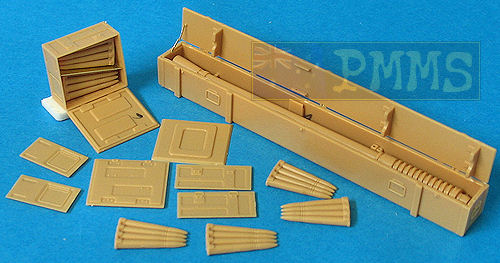
There are different sections for the two carriage options as well as the alternate parts for the manual and electric control versions, the parts numbers for the electric control version are shown in red which really does help in identifying what part goes with which version.
Some of the assembly sequences are quite involved due to the many small plastic and etched parts meaning you should be especially clear on what goes where by thoroughly studying the assembly sequences before doing anything.
There are a couple of minor bloopers in the instructions, in Step 17 for the GB Carriage Mk.II part E13 should be E14 and in Step 18 seat part E31 should be E41.
But overall the instructions are very good and there shouldn’t be any major problems during assembly if due care is taken.
|
But as with any kit there is room for improvement, the most obvious is the addition of the numerous power cables for the electric control version, the various chains and additional wiring on the transport carriage and other finer details if you really want to make it better detailed than it already is.
The only negative, if you could call it that is the build ability factor. Due to the complexity of some sub-assemblies (ammo rack and Stiffkey sight for example) with some requiring soldering and the finesse of the many small parts this may limit the appeal to more experienced modellers as some young and less experienced may encounter problems during assembly if not careful.
As the year draws to a close the subject of “kit of the year” comes up and this kit must feature very high in the list of nominations, certainly it’s the most impressive artillery kit released this year IMHO.
I’ll sum up with the well known quote “that’s not a Bofors, this is a Bofors”.
Very highly recommended.
Click on thumbnails for larger view









Detail Images






Click Browsers BACK button to return to page
| Bofors 40mm WWII AA Gun in detail Wings & Wheels Publications R 058 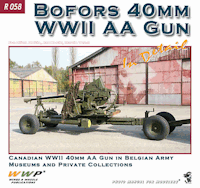 |
| WWII US War Department Technical Manual CD-ROM TM9-252 40mm Anti-aircraft
Gun (Bofors) Easy 1 Productions #T006 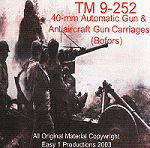 |
Thanks to Bronco Models for providing the review kit.



